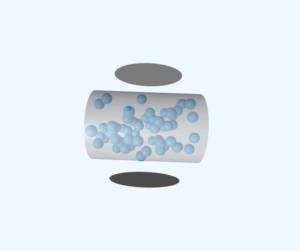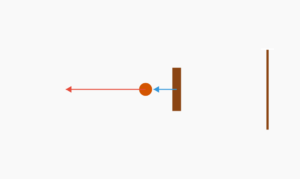Gas Mixture: Argon and Chlorine Kinetic Energy
KE Ratio: 1:1
Speed Ratio: 1.33 (Ar:Cl)
Example
Question:
A flask contains argon and chlorine in the ratio of 2:1 by mass. The temperature of the mixture is 27°C. Obtain the ratio of (i) average kinetic energy per molecule, and (ii) root mean square speed \(v_\mathrm{rms}\) of the molecules of the two gases. Atomic mass of argon = 39.9 u; Molecular mass of chlorine = 70.9 u.
Solution:
(i) The average kinetic energy per molecule of an ideal gas is \(\frac{3}{2}k_B T\), same for all gases at the same temperature. So, the ratio is \(1:1\).
(ii) For root mean square speed:
\[
\frac{1}{2} m v_\mathrm{rms}^2 = \frac{3}{2} k_B T \implies v_\mathrm{rms}^2 = \frac{3 k_B T}{m}
\]
Therefore,
\[
\frac{v^2_{\mathrm{rms,Ar}}}{v^2_{\mathrm{rms,Cl}}} = \frac{m_{\mathrm{Cl}}}{m_\mathrm{Ar}} = \frac{M_{\mathrm{Cl}}}{M_\mathrm{Ar}} = \frac{70.9}{39.9} = 1.77
\]
Taking square root,
\[
\frac{v_{\mathrm{rms,Ar}}}{v_{\mathrm{rms,Cl}}} = 1.33
\]
The speed above for argon is 1.33 times that for chlorine.
Physics Explanation
This simulation demonstrates the kinetic energy and speed differences between argon (monatomic) and chlorine (diatomic) molecules at the same temperature.
(ii) vrms = √(3kBT/m)
vrms(Ar)/vrms(Cl) = √(mCl/mAr) = √(70.9/39.9) ≈ 1.33
Where:
- kB = Boltzmann constant
- T = absolute temperature
- m = molecular mass (Ar = 39.9 u, Cl2 = 70.9 u)
- vrms = root mean square speed
Key Results
1. Both gases have the same average kinetic energy per molecule at the same temperature.
2. Argon atoms move faster than chlorine molecules by a factor of 1.33 (since they're lighter).
3. The mass ratio in the mixture (2:1) doesn't affect these molecular properties.



